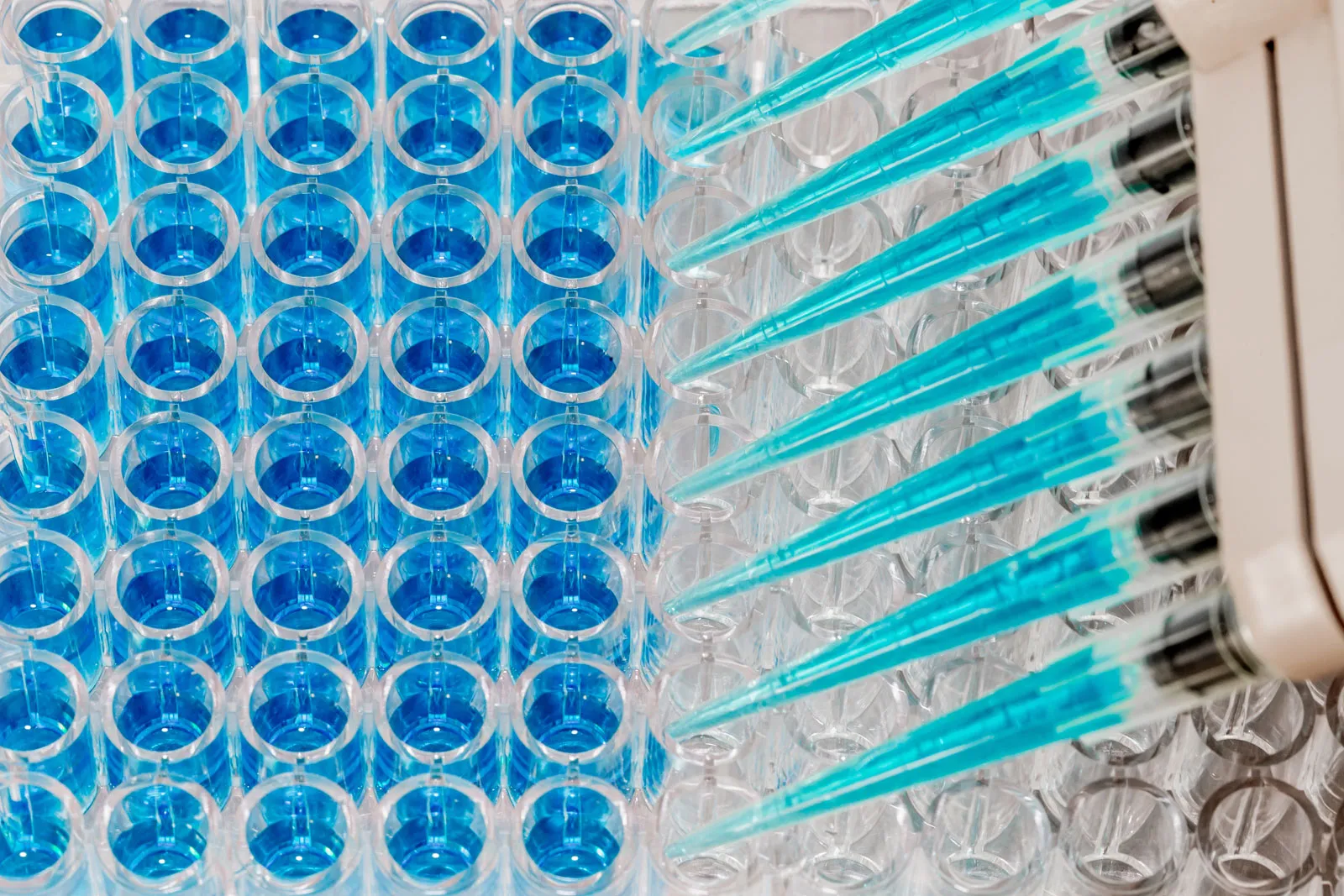Antibody measurement and biomarker quantification play a fundamental role in drug discovery and development. Accurate analytical methods delivering robust and reliable results directly impact regulatory approval outcomes and clinical trial success. The ELISA method is a standard approach for quantifying therapeutic antibodies and analyzing biomarkers in pharmaceutical development. ELISA assays have applications in key areas of therapeutic development, including immunogenicity assessment, pharmacokinetic studies and biomarker validation.
Let’s learn more about ELISA methodologies, applications and validation requirements for biomarker analysis and antibody assessments.
The fundamentals of ELISA assays
ELISA is a plate-based method developed for detecting and quantifying analytes such as proteins, peptides, hormones, and antibodies in complex matrices. In an ELISA assay, the target antigen is immobilized on the microplate surface and then complexed with antibodies complementary to the target antigen linked to a reporter enzyme. Researchers then detect the target antigen by measuring reporter enzyme activity via incubation. The antibody-antigen interaction is the most crucial component of an ELISA assay.
Several variants of ELISA assays are now available. However, all these formats are based on the same underlying principle:
- Coating/capture: immobilization of target analytes onto the plate surface
- Blocking: adding irrelevant proteins to cover unsaturated binding sites
- Probing/detection: incubating with antigen-specific antibodies
- Signal measurement: detecting the generated signal through primary or secondary tags
Some enzyme labels employed in ELISA assays are alkaline phosphatase and horseradish peroxidase. Other enzyme labels include catalase, acetylcholinesterase, and β-galactosidase. Several substrates are available commercially. However, the substrate choice depends on the instrumentation available and the required assay sensitivity.
Additionally, multiple assay formats are used in ELISA methodologies. These assay formats include direct, indirect, competitive, and sandwich ELISA. The key differences in these assay formats are the immobilization of target analytes via direct adsorption or indirectly through a capture antibody.
ELISA methodology and validation
A robust ELISA setup depends on a technically sound method development. Hence, a comprehensive method development and validation is critical for regulatory compliance and data reliability. The fundamental ELISA assay formats include direct, indirect, competitive, and sandwich assays. These assay formats have different analytical applications. A systematic approach to assay validation encompasses precision, accuracy, linearity, specificity, and stability. Establishing these parameters is critical for regulatory acceptance. Other crucial aspects of ELISA assay validation include cross-reactivity, interference, and matrix effects.
Drug developers should establish critical aspects of ELISA assays, such as control materials, qualified reference standards, and acceptance criteria for reliable and accurate assay performance. The critical documentation needed for assay validation in GLP Testing includes analytical procedures, quality control specifications, and validation protocols necessary for regulatory submissions. A rigorous validation protocol ensures regulatory acceptance and scientific validity of data to support clinical applications and drug development programs.
A poorly validated assay can have several potential issues. Hence, following regulatory guidelines and incorporating best practices is essential during assay validation. A significant cause of poor assay validation is the generation of false-negative and false-positive results. Proper care and planning are critical for successful ELISA validation. Common issues such as too much detection reagent or insufficient washing may yield high signals, which may generate false positive results. Besides, contamination or cross-reactivity may increase the background signal. High background signals may generate false-negative or false-positive results and impact accuracy. Moreover, failure to maintain lot-to-lot consistency may also lead to false-positive or false-negative results.
Advanced technologies and multiplexed ELISA assays
Today, conventional ELISA assay technologies have evolved into multiplexed systems. These multiplexed ELISAs can simultaneously measure multiple analytes in a single reaction volume, enhancing sample utilization and analytical efficiency. Multiplexed ELISA assays offer advanced capabilities compared to traditional assay systems. These assays include bead-based and electrochemiluminescence technologies for multi-analyte identification and quantification. Multiplexed ELISA assays offer enhanced throughput and cost-effectiveness over singleplex assays, making them an ideal choice for biomarker analysis and antigen quantification. Some of the technical advantages of multiplexed ELISA assays include decreased analytical time, reduced sample volume requirements, and enhanced statistical power through simultaneous detection of multiple biomarkers.
Must Read: Cell Cytotoxicity Assays in Toxicology: Ensuring Drug Safety
However, researchers should focus on adequate implementation of multiplexed platforms. These considerations include validation requirements, quality control protocols, and method development complexities for accurate and reliable ELISA analysis in a wide range of drug development applications. Hence, multiplexing technologies offer a bright future for ELISA methods in pharmaceutical research, enabling comprehensive antigen detection and biomarker profiling with enhanced efficiency.
Conclusion
The ELISA assay is a crucial technological platform for quantifying antibodies and analyzing biomarkers in modern drug discovery and development. A robust biological assay validation supports clinical decision-making and regulatory submissions. Immunoassay services specializing in biomarker analysis and biological assay validation ensure data integrity and reliability and accelerate developmental timelines. In conclusion, understanding the strategic importance of ELISA analysis in GLP and non-GLP testing will be critical in accelerating the success rates of pharmaceutical development.




